

Exploring our past to sort out myth from reality
Share this Page on
Facebook or Twitter

These are the voyages of the TimeShip Anachron.
Our Mission: To boldly explore the past, dispelling
mythinformation and mythconceptions
of American History along the way.
 Visit us on Facebook
Visit us on Facebook
Meet MythAmerica Series

Pt 1 Pt 2 Pt 3 Pt 4 Pt 5 Pt 6 Pt 7
Walk 1000 Miles in My Moccasins, Part 3
Catchin’ the American Dream
Are you old enough to remember the most popular automobile accessories of the 1950s/60s?

Yes, every cool teenager with a sports car—or even an old jalopy—had to have a pair of “lucky” fuzzy dice hanging from the rear-

Instead, the latest hot “lucky” accessory for rear-
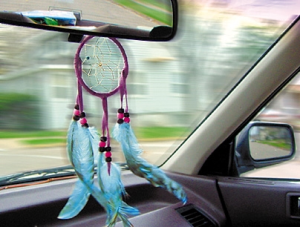
In fact, the dreamcatcher isn’t just a hot car accessory, it is a popular commercial theme for items such as wall plaques, statues, earrings, necklaces, and more.
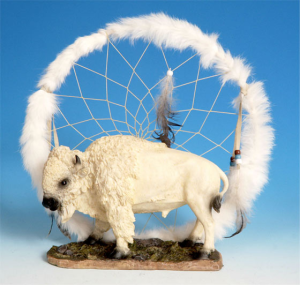

But it didn’t start out as a commercial item at all. Here’s what Wikipedia says about the dreamcatcher.
In Native American culture, a dreamcatcher … is a handmade object based on a willow hoop, on which is woven a loose net or web. The dreamcatcher is then decorated with personal and sacred items such as feathers and beads.
While dreamcatchers originated in the Ojibwa Nation [the ethnic group that used to be referred to as “Chippewa”] during the Pan-
According to the Encyclopedia of Insects, spiders had a great impact on the Native American culture that related to dreamcatchers. Each tribe had a different significance relating the two. As for the Cherokee people, the spider brought fire. Naʼashjéʼii Asdzą́ą́ʼ was the “Spider Woman” in Navajo culture and taught the women in the culture how to weave, and she was the “core of creation” in Pueblo legend. In the Sioux Indian tribes the term dream catcher means “spun by a spider” and they are used to catch good dreams.
American ethnographer Frances Densmore writes in her book Chippewa Customs (1929, republished 1979, pg. 113):
“Even infants were provided with protective charms. Examples of these are the “spiderwebs” hung on the hoop of a cradle board. These articles consisted of wooden hoops about 3½ inches in diameter filled with an imitation of a spider’s web made of fine yarn, usually dyed red. In old times this netting was made of nettle fiber. Two spider webs were usually hung on the hoop, and it was said that they “caught any harm that might be in the air as a spider’s web catches and holds whatever comes in contact with it.”
Traditionally, the Ojibwa construct dreamcatchers by tying sinew strands in a web around a small round or tear-
The Ojibwa believe that a dreamcatcher changes a person’s dreams. According to Konrad J. Kaweczynski, “Only good dreams would be allowed to filter through… Bad dreams would stay in the net, disappearing with the light of day.” Good dreams would pass through and slide down the feathers to the sleeper.
Another explanation of Lakota origin, “Nightmares pass through the holes and out of the window. The good dreams are trapped in the web, and then slide down the feathers to the sleeping person.” [Source]
Just as the dice supposedly “attract” good luck, the dreamcatcher was believed to repel bad dreams and attract good ones.
As noted, the dreamcatchers weren’t really “native” to many of the Native American tribes until the 1970s, but many have since made them their own and adopted them into their culture. Each tribe has tended to develop its own standard style for the dreamcatcher. Here’s a typical modern hand-
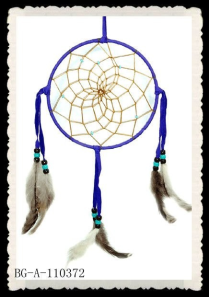
Back in the early 1800s in Georgia, the Cherokee people may not have had dreamcatchers for their homes. But some of them were certainly beginning to catch the American Dream!
We have seen that Georgia Cherokee leaders in the early 1800s were becoming Southern gentlemen, with impressive homes, fine clothes, plantations, thriving businesses such as taverns, trading posts, and ferry boats, and sons whom they sent away to higher learning institutions. Successful men such as Major Ridge and his son John, Chief Vann and his son Rich Joe Vann, and Charles Hicks gave strong evidence that the Cherokee were certainly capable of becoming “civilized” like the Anglo-
One other significant leader who fit this profile was Principal Chief John Ross, who was, as his title indicates, the most influential Cherokee leader by the mid-
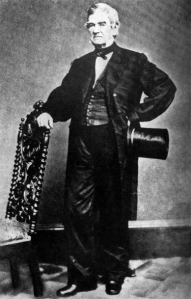
Here’s his home, The John Ross House in Rossville, Georgia, still preserved as it looked in the 1830s.
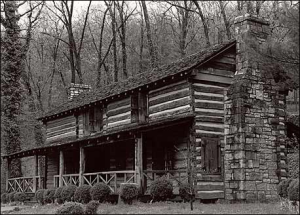
As with many Cherokee leaders, Ross was of mixed Native American and Scots ancestry.
Ross (also known by his Cherokee name, Guwisguwi) was born in Turkeytown (in modern day Alabama), along the Coosa River, to Mollie McDonald, and Daniel Ross, an immigrant Scottish trader. Because he was born to a Cherokee mother, Ross was considered to be a member of her Bird Clan by birth.
Ross’ mother and grandmother were of mixed Scots-
Ross spent his childhood with his parents in the area of Lookout Mountain. He saw much of Cherokee society as he encountered the full-
Ross began a series of business ventures. He derived the majority of his wealth from cultivating 170 acres tobacco in Tennessee worked by twenty slaves.
In 1816 he founded Ross’s Landing (now Chattanooga, Tennessee), served by a ferry crossing. In addition, Ross established a trading firm and warehouse. In total, he earned upwards of $1,000 a year ($13.7 thousand in today’s terms). …
In 1827, Ross moved to Rome, Georgia, to be closer to New Echota, the Cherokee capital. In Rome, Ross established a ferry along the headwaters of the Coosa River close to the home of Major Ridge, an older wealthy and influential Cherokee leader. By December 1836, Ross’s properties were appraised at $23,665 ($500,837 today). He was then one of the five wealthiest men in the Cherokee Nation. [Source]
Yes, John Ross was also livin’ the American Dream. For hadn’t one of the Founding Fathers of that American Dream reiterated over and over that Native Americans had a right to that dream too?
“I shall rejoice to see the day when the red men, our neighbors, become truly one people with us, enjoying all the rights and privileges we do and living in peace and plenty as we do, without anyone to make them afraid, to injure their persons or to take their property without being punished for it according to fixed laws.” –Thomas Jefferson: Address to the Cherokee Chiefs, 1808.
All they had to do was go along with the “civilization” program that the American Government sponsored. And go along with it they did!
But, of course, all those pious platitudes had been stated BEFORE gold was discovered in them thar hills of Georgia in 1828. Them thar hills … in territory recognized by the government of the United States of America as belonging to the Cherokee Indians. Unfortunately for the Cherokee, the State of Georgia was not inclined to feel quite as obligated to recognize “prior claims” on land just because some politicians in Washington said so. States’ rights and all that.
In fact, Georgia had good reason to not feel so obligated, because in spite of Jefferson’s many platitudes about the Indians, he had signed the “Compact of 1802” which gave a slightly different perspective on reality:
The Georgia compact of 1802 involved the Cherokee, the state of Georgia, and the Federal government. Who would control Indian lands? The struggle that ensued over the answer to that question set up the most violent social cataclysms of the 19th century.
Alabama and Mississippi were cut from land that was formerly part of Georgia. The federal government disputed Georgia’s claim to the land, but in getting her to quit her claim to it Thomas Jefferson secretly promised that the federal government would extinguish, at its own expense, title to Cherokee lands within the reserved limits of Georgia as soon as it could be done “peaceably and on reasonable terms.” Under this compact, which would take 40 years to fulfill, any lands that were vacated by the Indians would immediately became the possession of the state, not of the federal government – a egregious violation of treaties, the Constitution’s ‘supremacy clause,’ and the Commerce Clause. [Savages and Scoundrels]
Evidently Mr. Jefferson had a number of ideas of just how this “peaceable” goal could be attained. Including this:
In a letter to William Henry Harrison (1803), written as the diplomatic crisis leading to the Louisiana Purchase unfolded, Jefferson suggested that if the various Indian nations could be encouraged to purchase goods on credit, they would likely fall into debt, which they could relieve through the sale of lands to the government. [Monticello.org]
Yes, in spite of Jefferson’s assurances to the Delaware Indians in 1808 …
“You will unite yourselves with us,” President Jefferson said, “join our great councils and form one people with us. And we shall all be Americans. You will mix with us by marriage. Your blood will run within our veins and will spread with us over this great continent.”
…about the only thing that was guaranteed was the mixed blood. But not TOO much mixing. Sure, lots of Scots traders and similar fellows had taken Indian squaws as wives. They were, after all, way out in the boonies where most Scots ladies likely didn’t want to go. So needing wives, they were happy to mix with the Natives.
But John Ridge and other Cherokees very quickly found out that the average American hadn’t the slightest interest in following Jefferson’s blood mixing ideas. Remember the rigorous school in Connecticut attended by Major Ridge’s son John and nephew Elias Boudinot? Actually, it was the “Foreign Mission School” in Cornwall established in 1817 to bring Christianity and Western culture to non-
Approximately one hundred young men from non-
The Cornwallians may have been of “good character,” but they weren’t much of “good will.” They were willing to donate their money and property—but not their daughters as wives for the young Native American men who came there. Major Ridge’s son John fell in love with and married Sarah Northrup, the daughter of the steward of the school, in 1824, a marriage strongly condemned by the local residents. After this, John became quite disillusioned about the promises of the Indians and the Anglos becoming “one big happy family.”
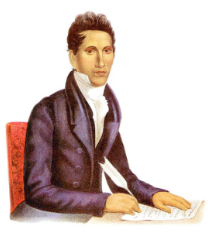
And when John’s cousin Elias Boudinot became engaged to local Harriet Gold, her family and the other residents “bitterly opposed” the marriage… and burned the couple in effigy. (They married in 1826 anyway.)
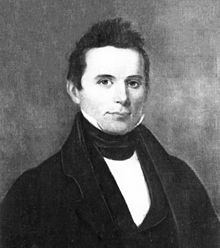
You have to admit by the looks of the portraits above that neither young man (both of them were of mixed race themselves) matched the standard conception of some sort of “hideous heathen savage.” Elias Boudinot (known among the Cherokee as Buck Watie), as a matter of fact, got his “English” name in an unusual way. In 1818, on the way to the Foreign Mission School, Buck Watie was introduced in New Jersey to Elias Boudinot, president of the American Bible Society, and president of the Second Continental Congress.
He and Watie impressed each other. Watie asked Boudinot for permission to use his name, which he gave. When enrolled at the Foreign Mission School, Watie started using the name Elias Boudinot, which he kept for the rest of his life.
In 1820, Boudinot officially converted to Christianity, attracted to its message of universal love. His Christian belief informed his work with the Cherokee Nation. In 1824 he collaborated with others in translating the New Testament into Cherokee and having it printed in the syllabary created by Sequoyah. [Source]
And Elias Boudinot the Cherokee was a very eloquent writer and speaker, and spokesman for his Cherokee people, as can be seen in these excerpts from one of his speeches soliciting support for the aspirations of the Cherokees in New Echota to become even more civilized:
Elias Boudinot 1826 “An Address to the Whites, Philadelphia, First Presbyterian Church
Some there are, perhaps even in this enlightened assembly, who at the bare sight of an Indian, or at the mention of the name, would throw back their imaginations to ancient times, to the ravages of savage warfare, to the yells pronounced over the mangled bodies of women and children, thus creating an opinion, inapplicable and highly injurious to those for whose temporal interest and eternal welfare, I come to plead.
What is an Indian? Is he not formed of the same materials with yourself? For of one blood God created all the nations that dwell on the face of the earth. Though it be true that he is ignorant, that he is a heathen, that he is a savage; yet he is no more than all others have been under similar circumstances. Eighteen centuries ago what were the inhabitants of Great Britain? You here behold an Indian, my kindred are Indians, and my fathers sleeping in the wilderness grave they too were Indians. But I am not as my fathers were — broader means and nobler influences have fallen upon me. Yet I was not born as thousands are, in a stately dome and amid the congratulations of the great, for on a little hill, in a lonely cabin, overspread by the forest oak, I first drew my breath; and in a language unknown to learned and polished nations, I learnt to lisp my fond mother’s name. In after days, I have had greater advantages than most of my race; and I now stand before you delegated by my native country to seek her interest, to labour for her respectability, and by my public efforts to assist in raising her to an equal standing with other nations of the earth.
The time has arrived when speculations and conjectures as to the practicability of civilizing the Indians must forever cease. A period is fast approaching when the stale remark “Do what you will, an Indian will still be an Indian,” must be placed no more in speech. . . . It needs not the display of language to prove to the minds of good men, that Indians are susceptible of attainments necessary to the formation of polished society. It needs not the power of argument on the nature of man, to silence forever the remark that “it is the purpose of the Almighty that the Indians should be exterminated.” It needs only that the world should know what we have done in the last few years, to foresee what yet we may do with the assistance of our white brethren, and that of the common Parent of us all. . . .
[Speaking of the 18 schools established in Georgia Cherokee territory:] Most of the schools are under the care and tuition of Christian missionaries, of different denominations, who have been of great service to the [Cherokee] nation, by inculcating moral and religious principles into the minds of the rising generation. . . . it may be said with truth, that among no heathen people has the faithful minister of God experienced greater success, greater reward for his labour, than in this. He is surrounded by attentive hearers, the words which flow from his lips are not spent in vain. …
There are three things of late occurance, which must certainly place the Cherokee Nation in a fair light, and act as a powerful argument in favor of Indian improvement. First. The invention of letters.
Second. The translation of the New Testament into Cherokee.
And Third. The organization of a Government. The Cherokee mode of writing lately invented by George Guest [Sequoyah], who could not read any language nor speak any other than his own, consists of eighty-
Yes, both John Ridge and Elias Boudinot, as well as an increasing number of others in their Cherokee Nation, were capable of much more than beating a tom-
But evidently the locals in Connecticut hadn’t read Jefferson’s encouragement about mixin’ blood and spreadin’ across the land together. Nor did they have any interest in the amazing development of the Cherokee Syllabary, the publication of a Cherokee newspaper, or the size of the libraries that some Cherokee Southern gentlemen were acquiring. What they knew was just that no decent white girl should have the slightest interest in a heathen Indian. (Even if he was a Christian heathen Indian, evidently.) In fact, they felt so strongly about this “problem” that the Foreign Mission School was forced to close in 1826, in spite of its success in educating aboriginal young men.
And back in Georgia Cherokee territory, the nearby Georgians had an even bigger problem with the Cherokees. Their civilized Cherokee plantations and towns and businesses and schools were sitting on land that the citizens of Georgia felt rightly belonged to Georgia. Hadn’t Jefferson promised it to them in the Compact of 1802?
The wisest of the Cherokee leaders were well aware that it had long been the goal of many U.S. politicians to “solve” the “Indian problem” by removing all of the Indians, of the various tribes, from territories settled by whites. Originally there had been millions of them, of course. But the diseases introduced by the Europeans, and the superior military force of the US, had decimated them any time they resisted encroachment on their lands. So the number left to be “dealt with” was shrinking drastically.
Before the advent of the steam train, no one had seriously thought that the US would spread out beyond the Mississippi River. So the obvious solution from the point of view of many was to create a repository for the last of the Indians beyond that river, and encourage or force them to leave their homelands and go there.
But there were still some Anglo advocates of letting the Indians remain in their own territories, if they would only, as Jefferson had encouraged, adapt to the settled life of “civilization” and take up farming and such rather than hunting for sustenance. The encroachment of the whites had long been driving the game from the forests and fields of one area after another anyway, making it difficult or impossible for the Indians to keep their “old ways.”
Among all the tribes, the Cherokee were the most dedicated to the goal of settling down and becoming farmers rather than hunters. And knowing that they had advocates both in Washington and in other states, they held to their hope that their efforts would be rewarded with permission to stay in their homeland.
Unfortunately, the most powerful man in the nation by 1830, President of the United States Andrew Jackson (seen here in an 1845 daguerrotype photo)—had other plans.
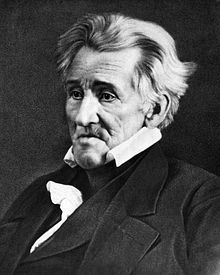
He had campaigned successfully for the presidency in 1828 on a platform that included adamantly advocating the removal of all Indians from their homelands in the east to a Federal Indian territory west of the Mississippi. In 1830 his efforts succeeded when the US congress passed the Indian Removal Act.
While Native American removal was, in theory, supposed to be voluntary, in practice great pressure was put on Native American leaders to sign removal treaties. Most observers, whether they were in favor of the Indian removal policy or not, realized that the passage of the act meant the inevitable removal of most Indians from the states. Some Native American leaders who had previously resisted removal now began to reconsider their positions, especially after Jackson’s landslide re-
The Removal Act was strongly supported in the South, where people were eager to gain access to lands inhabited by the Five Civilized Tribes. In particular, Georgia, the largest state at that time, was involved in a contentious jurisdictional dispute with the Cherokee nation. President Jackson hoped removal would resolve the Georgia crisis.
The Indian Removal Act was highly controversial. While most European Americans during this time favored the passage of the Indian Removal Act, there was significant opposition. Many Christian missionaries, most notably missionary organizer Jeremiah Evarts, protested against passage of the Act. Future U.S. President Abraham Lincoln also opposed the Indian Removal Act. In Congress, New Jersey Senator Theodore Frelinghuysen and Congressman Davy Crockett of Tennessee spoke out against the legislation. The Removal Act was passed after bitter debate in Congress.
There was no mention in the act of any “special dispensation” for “civilized” Indians with plantations and libraries and suits with tall collars and dark cravats. An Indian was an Indian was an Indian.
At this point the optimistic Cherokee leaders such as Major Ridge and John Ross began to panic. A small number of Cherokee, perhaps 500-
John Ross led a delegation to Washington to attempt to plead the Cherokee’s case. Rebuffed by Jackson, they eventually took two cases to the US Supreme Court.
On December 20, 1828, Georgia, fearful that the United States would be unable to effect the removal of the Cherokee Nation, enacted a series of laws which stripped the Cherokee of their rights, suppressed their government, and regulated activities on their lands. These were calculated to force the Cherokee to move.
The Cherokee presented two cases to The Court requesting it to stop this harassment. They lost the first case, but the second was resolved in their favor by the court.
In Worcester v. Georgia, the Court found that Georgia could not extend its laws to the Cherokee Nation because that was a power of the federal government. Marshall stated that “the acts of Georgia are repugnant to the Constitution, laws and treaties of the United States. They interfere forcibly with the relations established between the United States and the Cherokee nation, the regulation of which, according to the settled principles of our Constitution, are committed exclusively to the government of the Union.” The Cherokee were considered sovereign enough to legally resist the government of Georgia, and were encouraged to do so.
Ross and the others were elated by the outcome. But their joy was short-
(Some folks in the early 21st century think there are “problems” with the modern Presidency taking too much power to itself. They ought to have been living back only forty years after the Constitution was written, when it seems that the document was just as vulnerable to being ignored as it seems to some to be today!)
To double the misery, at the same time that Jackson was ignoring the Supreme Court, the State Government of Georgia gleefully put in place its infamous 1832 “Sixth Land Lottery.” All of the territory currently belonging to the Cherokee was divided up by the state into plots, and a lottery was set up whereby each of those plots would be awarded by lot to white Georgia citizens.
Under the system, citizens of the state, but not the native Indians, could register for a lottery in which these lands would be raffled off. Each qualified individual was entitled to at least one chance. If the person belonged to a specially designated group such as veterans, orphans, or heads of families, they were given two chances.
Tickets bearing the names of the registrants would then be sent to the state capitol at Milledgeville, where they were placed in a large rotating drum.
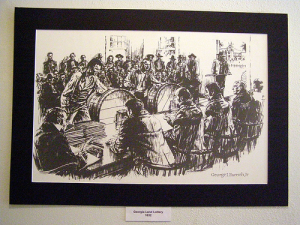

Tickets with land-
Five earlier lotteries, beginning in 1805, had been held to divvy up the lands of the Creek Indians. The sixth, in 1832, was to divide up the Cherokee territory. What with gold having been found in parts of that territory in 1828, there was much excitement over this lottery in particular. There was always the chance you might win land that had an actual gold mine in the lottery! And then there were the other plum prizes…
With the additional attraction of such estates as those of John Ridge, John Ross and David Vann, it is hardly surprising that the ethical questions of the lottery were given little attention.
A popular song of the day summed up the general attitude:
“All I want in this creation,
“Is a pretty little wife and a big plantation,
“Away up yonder in the Cherokee Nation.”
[“Gambling Away the Inheritance: The Cherokee Nation and Georgia’s Gold and Land Lotteries of 1832-
The “winners” in the lottery were not able to move onto “their” property until the current resident Cherokee people were “removed.” But given the developments in Washington, everyone knew that would be “soon.”
The Cherokee’s American Dream was about to become the Great American Nightmare. One far too big to be captured and dissipated by a dreamcatcher.